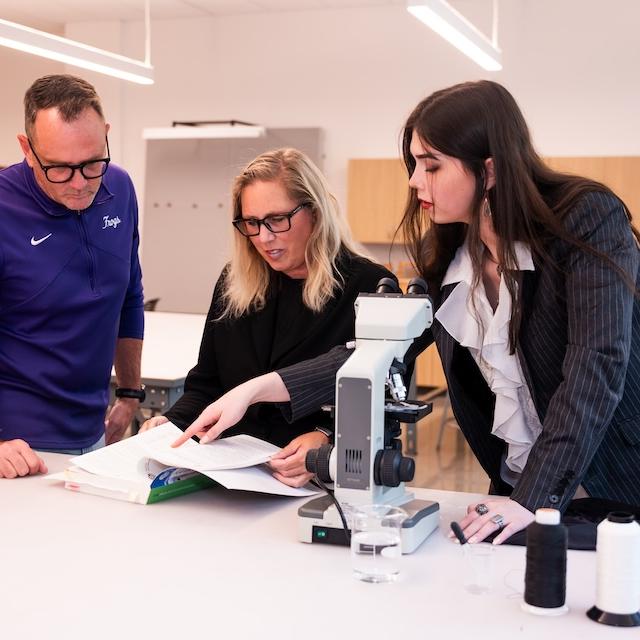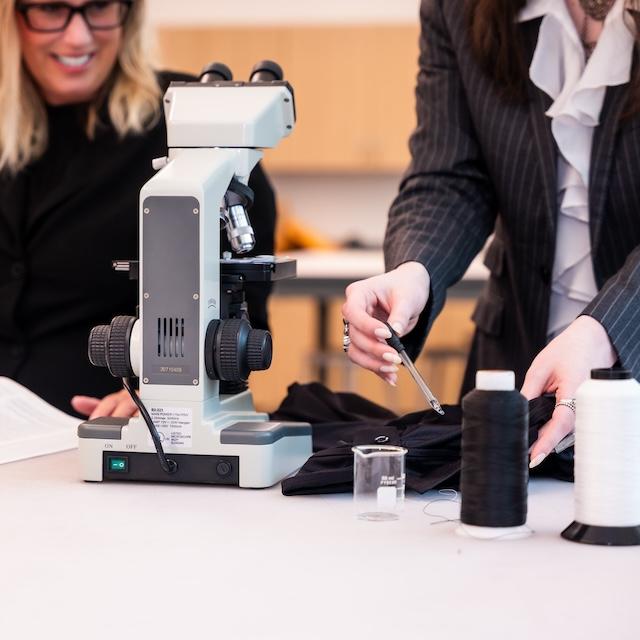
Undergraduate Research Explores Hidden Costs of Fashion
After discovering that plastic particles from textiles can end up in our organs, Adelaide Lovett wanted to explore the impacts that don’t show up under a microscope. This led to an undergraduate-led research project from Texas Christian University that was published in a 2025 edition of Textiles, a peer-reviewed journal. The research, led by Lovett, explores the environmental and health impacts of synthetic textiles, a topic that aligns with the senior’s dual academic focus in fashion merchandising and psychology.
Lovett’s research, guided by faculty mentors and corresponding authors Charles Freeman, chair of fashion merchandising, and Leslie Browning-Samoni, instructor II, evolved into a comprehensive review of how synthetic fibers contribute to the spread of microplastics, nanoplastics and microplastic fibers throughout ecosystems — even within the human body.
“This project began simply by approaching Professor Freeman with a concept of bridging the world of psychology with fashion,” Lovett explained. “I have always been interested in combining ideas or topics that are not thought to be intimately related, and the mentorship with Freeman and Samoni allowed me to actualize goals I hadn’t even consciously set for myself.”
 The research examines how fiber production, textile finishes, laundering and disposal
all play roles in the release of plastic particles. Startling evidence shows these
particles are now being found in human organs, including the heart, lungs and liver.
This issue intersects with Lovett’s work in the lab with Timothy Barth, psychology
professor and associate dean for graduate studies in TCU’s College of Science & Engineering,
on ethical and moral decision-making, as well as her coursework in neuroscience as
part of her dual degree.
The research examines how fiber production, textile finishes, laundering and disposal
all play roles in the release of plastic particles. Startling evidence shows these
particles are now being found in human organs, including the heart, lungs and liver.
This issue intersects with Lovett’s work in the lab with Timothy Barth, psychology
professor and associate dean for graduate studies in TCU’s College of Science & Engineering,
on ethical and moral decision-making, as well as her coursework in neuroscience as
part of her dual degree.
“The societal problems we face today are complex and require multiple perspectives involving the integration of academic disciplines,” Barth said. “Engaging undergraduate students in the research enterprise provides them with a foundation to utilize the skills necessary to confront a variety of contemporary problems, as well as the new issues that we may encounter in the future. Adelaide’s experience in research across disciplines is an example of what can be accomplished.”
This type of interdisciplinary work is at the heart of TCU’s strategic pillar of Research, Scholarship and Creative Activities. It also highlights how solutions rarely stop at the border of a single major or college.
Lovett’s study calls for actionable solutions: biodegradable finishes, better filtration systems, circular fashion models and interdisciplinary collaboration across science, engineering and design.
“This was truly a passion project from the beginning to now as I continue research into other connections between the two fields and in the humanities and sciences,” Lovett said. “This project has further widened my scope of interests.”
Lovett recently used her broad skill set alongside Samoni and fellow students to earn the 2025 Best Innovation Award at NASA’s Spaceflight Human Optimization and Performance Summit. The TCU team’s entry in the Technology Collaboration Center Wearables Workshop focused on designing flexible, low-profile seams that prevent the intrusion of hazardous lunar dust during missions.
Read more about the NASA design from TCU News, and read the Textiles research article, “Fashion to Dysfunction: The Role of Plastic Pollution in Interconnected Systems of the Environment and Human Health.”
